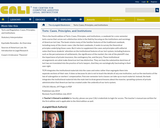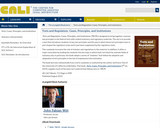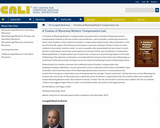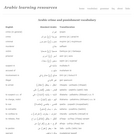
162 Results


Sources of Law
- Subject:
- Political Science
- Material Type:
- Reading
- Author:
- Annette Howard
- Date Added:
- 01/08/2020

Sources of Law
- Subject:
- Political Science
- Material Type:
- Module
- Author:
- Kris Seago
- Date Added:
- 07/26/2018


There are few ideas more sacred than the physical, emotional, and spiritual connections individuals have had with nature. The love of these beautiful landscapes has inspired countless generations to protect and preserve these lands and to make sure that the wild, untamed beauty will continue to awe future generations who have yet to come across their magnificence. On March 1, 1872, Yellowstone National Park was federally recognized as the countrys first protected area, 44 years before the National Park Service was founded in 1916. And with this first step, the conservation, culture, history, and preservation of parks and protected areas began. Not only do these parks and protected areas ensure the vitality of natural resources, but of historical and cultural resources as well. Constructing and defining the National Park Service as the revered organization that it is today was no easy task. While some individuals have used their talents to create and preserve the physical landscapephysically building the parks and developing policies and lawsothers have used their literary and artistic skills to showcase their beauty and history. No one person is the guardian or champion of these protected areaswith collaboration, vision, and connection to the land, we are part of the parks equally as the parks are part of ourselves. Created by Clemson University Libraries.
- Subject:
- History
- U.S. History
- Material Type:
- Diagram/Illustration
- Primary Source
- Unit of Study
- Provider:
- Digital Public Library of America
- Provider Set:
- DPLA Exhibitions
- Date Added:
- 02/01/2014

This is the fourth edition of Torts: Cases, Principles, and Institutions, a casebook for a one-semester torts course that carves out a distinctive niche in the field by focusing on the institutions and sociology of American tort law. The book retains many of the familiar features of the traditional casebook, including many of the classic cases. Like the best casebooks, it seeks to survey the theoretical principles underlying those cases. But it aims to supplement the cases and principles with editorial notes that focus students’ attention on the institutional features of our tort system, including features such as the pervasiveness of settlements, the significance of the market, the role of the plaintiff's bar, the importance of private insurance, the contingency fee, and the jury. These institutional arrangements are what make American tort law distinctive. They are how the substantive doctrines of tort law are translated into the practice of torts lawyers. And they are sociologically fascinating in their own right.
TCPI integrates the institutional materials into the cases and notes rather than segregate them into separate sections of their own. It does so because its aim is not to teach the details of any one institution, such as the mechanics of the law of subrogation or workers’ compensation. Few one-semester torts classes can take up so much material. Instead, the book integrates the institutional material into the main text to draw general lessons about the massive, sprawling systems of private administration that American law has created under the umbrella of our torts system.
- Subject:
- Law
- Material Type:
- Textbook
- Provider:
- The Center for Computer Assisted Legal Instruction (CALI)
- Provider Set:
- The eLangdell Bookstore
- Author:
- John Fabian Witt
- Date Added:
- 12/03/2019

Plain-spoken and convivial, this casebook makes a deliberate effort to explain the law, rather than to provide a mere compilation of readings and questions. Simple concepts are presented simply. Complex concepts are broken down and accompanied by examples and problems.
By being clear and straightforward, the casebook aims to quickly get students to the point where they can navigate regions of gray and build nuanced arguments. The book is written from the conviction that when students stop to puzzle over something, it should be because the law itself puzzles, not because the book obfuscates.
Students describe the book as easy to read. A key aim is context, with explanations of how pieces of doctrine fit into the bigger picture. There is also a continual effort to plug doctrine into the real world of practice, getting students to think about litigation strategy and tactics.
Another key feature is a high-degree of organization. Doctrine is explained upfront, independent of and before the cases. After the cases, there is no notes-and-questions mishmash. Historical notes, check-your-understanding questions, questions to ponder, and problems are all separately labeled as such.
The readings are rich with variety. The classic cases are here, of course. But there are also atypical readings that allow students to see tort law from different perspectives, including an opening statement, a closing argument, administrative-enforcement letters, an excerpt from a novel, and an opinion on tribal law from a Navajo court. Many selections are also startlingly modern, with facts involving texting-and-driving, alcoholic energy drinks, Facebook libel, suddenly accelerating Toyotas, and the misery of a six-hour tarmac delay.
- Subject:
- Law
- Material Type:
- Textbook
- Provider:
- The Center for Computer Assisted Legal Instruction (CALI)
- Provider Set:
- The eLangdell Bookstore
- Author:
- Eric E. Johnson
- Date Added:
- 12/03/2019

Plain-spoken and convivial, this casebook makes a deliberate effort to explain the law, rather than to provide a mere compilation of readings and questions. Simple concepts are presented simply. Complex concepts are broken down and accompanied by examples and problems.
By being clear and straightforward, the casebook aims to quickly get students to the point where they can navigate regions of gray and build nuanced arguments. The book is written from the conviction that when students stop to puzzle over something, it should be because the law itself puzzles, not because the book obfuscates.
Students describe the book as easy to read. A key aim is context, with explanations of how pieces of doctrine fit into the bigger picture. There is also a continual effort to plug doctrine into the real world of practice, getting students to think about litigation strategy and tactics.
Another key feature is a high-degree of organization. Doctrine is explained upfront, independent of and before the cases. After the cases, there is no notes-and-questions mishmash. Historical notes, check-your-understanding questions, questions to ponder, and problems are all separately labeled as such.
The readings are rich with variety. The classic cases are here, of course. But there are also atypical readings that allow students to see tort law from different perspectives, including an opening statement, a closing argument, administrative-enforcement letters, an excerpt from a novel, and an opinion on tribal law from a Navajo court. Many selections are also startlingly modern, with facts involving texting-and-driving, alcoholic energy drinks, Facebook libel, suddenly accelerating Toyotas, and the misery of a six-hour tarmac delay.
Please note that the publisher requires you to login to access and download the textbooks.
- Subject:
- Law
- Material Type:
- Textbook
- Provider:
- The Center for Computer Assisted Legal Instruction (CALI)
- Provider Set:
- The eLangdell Bookstore
- Author:
- Eric E. Johnson
- Date Added:
- 12/03/2019

Torts and Regulation: Cases, Principles, and Institutions (TRCPI) is designed to bring together common law principles in the field of torts with related statutory and regulatory materials. The aim is to provide a text that introduces students to key tort principles and the way in which those tort principles have in part shaped the regulatory state and in part been supplanted by the regulatory state.
This casebook increases the role of statutes and regulations in the material. In addition, it offers a major innovation by leading the students into the ways in which basic tort doctrine animate fields of statutory law. In particular, the book adopts a series of “modules” that follow the adoption and adaptation of tort principles in the law of employment discrimination.
The book borrows substantially from a torts casebook co-authored by the author and Karen Tani of the University of California at Berkeley. That book, Torts: Cases, Principles, and Institutions (4th ed., 2019), supplies much of the basic tort material that follows here in TRCPI.
- Subject:
- Law
- Material Type:
- Textbook
- Provider:
- The Center for Computer Assisted Legal Instruction (CALI)
- Provider Set:
- The eLangdell Bookstore
- Author:
- John Witt
- Date Added:
- 08/01/2019

Trademark Law: An Open-Source Casebook is a free, “open” textbook designed for a four-credit trademark course, which is what I teach at NYU School of Law. Model syllabi for four-credit and three-credit courses are available in the Faculty Resources section of this website.
- Subject:
- Law
- Material Type:
- Textbook
- Provider:
- New York University
- Author:
- Barton Beebe
- John M. Desmarais
- Date Added:
- 08/29/2019

This course focuses on the legal mechanisms to protect distinctive logos, slogans and other visual marks associated with products from unauthorized use by other parties. This is an introductory level course and no prior knowledge of intellectual property law or law in general is required.
The course opens with a discussion of what trademarks are and distinguishes them from other forms of intellectual property. We’ll also look at what constitutes a trademark and related phenomena such as service marks, trade names and trade dress. We will also look at the symbols that may be and typically are used to indicate claimed trademarks.
Module two focuses on securing trademark protection and looks at the federal agencies that enforce trademark law and the mechanisms by which one can register trademarks, and the costs associated with doing so. We will look at the various steps involved in registering a trademark and the steps that can be taken to appeal denials by the USPTO. Finally, we will look at the limited roles of state law and common law in trademark protection.
Module three focuses on the important “distinctiveness” requirement for trademark protection. We will look at the differences among descriptive, suggestive, arbitrary and fanciful marks. The module also covers cases that illustrate the nuances of the series of rules and how distinctiveness can be acquired or lost depending on how the marks are used in the context in which they are used.
Module four covers trademark enforcement. We will start with trademark searches, including how goods or services owners can determine whether phrases and marks are trademarked and the extent to which they can trademark their own. We’ll go through the various available databases and discuss steps that are important to maintain a trademark’s effectiveness. We will also cover transfers of trademark rights.
The final module looks at infringement. We will discuss various types of trademark dilution and then look at the important defense of fair use. Finally, the course ends with a discussion of the various remedies that are available once trademark infringement has been established.
Upon completion of this course, the viewer will be able to apply the basics of trademark law and will, hopefully, be encouraged to take advantage of our other courses in the intellectual property field.
- Subject:
- Intellectual Property Law
- Law
- Material Type:
- Assessment
- Interactive
- Lesson Plan
- Reading
- Teaching/Learning Strategy
- Author:
- Stephen Haas
- Date Added:
- 12/11/2019

This OER provides a substantial set of readings on transportation law and policy, suitable for use in a variety of disciplines and educational settings, including law, economics, urban planning, history, engineering, sociology, and more.
- Subject:
- General Law
- Law
- Material Type:
- Syllabus
- Provider:
- University of Iowa
- Provider Set:
- Iowa Research Online
- Author:
- Gregory H. Shill
- Date Added:
- 06/12/2023

A Treatise of Wyoming Workers’ Compensation Law seeks both to introduce Wyoming workers’ compensation students to the law of their own jurisdiction, and to provide a continuing resource to those same students as they embark on workers’ compensation legal practice after graduation. In this way, the text fills a gap in the literature by serving as a concrete exemplar of what it means to assist students in becoming “practice-ready” as soon as possible after graduating from law school. In short, practice ready lawyers must have some exposure to the law of their own jurisdictions. Furthermore, Wyoming Workers’ Compensation Law is meant to be a resource to all practicing lawyers in the state of Wyoming. This objective is intimately connected with the mission of the University of Wyoming as a Land Grant Institution broadly striving to serve the needs (including legal needs) of Wyoming citizens.
Substantively, the treatise canvasses the traditional areas of workers’ compensation law: employee/employer definitions, causal connection to work, evaluation of the extent of disability, types of benefits, and a brief discussion of the Wyoming administrative structure. In several places the treatise first introduces a substantive area of law generally, for example “causal connection,” and then focuses on how Wyoming law analyzes the area of law. In discussing some substantive areas of workers’ compensation law, the treatise underscores especially unique Wyoming idiosyncrasies. Not content to merely “restate” the law, the treatise in certain areas subjects the law to academic criticism and suggests legal reform in order to stimulate broader discussion of the legal doctrine.
- Subject:
- Law
- Material Type:
- Textbook
- Provider:
- The Center for Computer Assisted Legal Instruction (CALI)
- Provider Set:
- The eLangdell Bookstore
- Author:
- Michael C. Duff
- Date Added:
- 12/01/2019

These Trigonometry lecture videos coterminal angles, trig functions, quadrantal angles, special acute angles, co-functions, finding theta, reference angles, trig functions, radian measure, arc length, area of a sector, graphing sine and cosine using t-table, amplitude and frequency, phase shift for sine and consine, vertical shift, tangent curve, cotangent transformations, evaluating trig identities, trig expressions, sum and difference for cosine, double and half angle identities, inverse, principal values, solving difficult trig equations, law of cosines, area of a triangle, and vectors and bearing.
- Subject:
- Mathematics
- Trigonometry
- Material Type:
- Lecture
- Provider:
- Bossier Parish Community College
- Author:
- Stacey Black
- Date Added:
- 10/11/2017

This list presents a basic set of vocabulary words that broadly deal with issues of crime, law, and legal punishment. The words include nouns and verbs used to describe concepts and processes such as criminal, suspect, prison, and indictment. The majority of words contained within the website are nouns, and some verbs are interspersed. The words and verbs are presented in both modern standard and colloquial Egypt, and feature Arabic text and transliteration.
- Subject:
- Arts and Humanities
- Languages
- Material Type:
- Reading
- Provider:
- Arabic Desert Sky
- Date Added:
- 09/17/2013

Il volume rappresenta la tappa finale della prima stagione di implementazione del Progetto ABACUS (giugno 2019 - settembre 2020), sostenuta dal finanziamento pubblico garantito dalla Regione Siciliana e dalla Presidenza del Consiglio dei Ministri. In tal senso, la pubblicazione raccoglie sia una sezione di materiali di discussione critica sul percorso progettuale e sui primi esiti maturati, sia una ricca parte di contributi tematici offerti da referenti istituzionali, studiosi ed esperti, docenti accademici e ricercatori, professionisti e rappresentanti di organismi del Terzo settore Sono state così affrontate ed esaminate differenti tematiche e problematiche socio-culturali e socio-economiche, e prospettive e approcci metodologico-operativi tra loro affini e convergenti, che si sviluppano a cavallo delle politiche sociali, giovanili e culturali, della progettazione sociale e culturale, dell'innovazione sociale e della diversità culturale, in differenti contesti socio-territoriali siciliani e italiani, con una particolare attenzione per quelle iniziative che rappresentano casi paradigmatici in cui le istanze istituzionali, della ricerca, dell'educazione e della formazione si incontrano con le aspettative dei pubblici differenziati e, specialmente, delle giovani generazioni, anche sull'orizzonte della innovazione dell'occupazione giovanile.
- Subject:
- Arts and Humanities
- World Cultures
- Material Type:
- Textbook
- Author:
- Alessandra Caravale
- Alessia Bono
- Andrea De Tommasi
- Andrea Messina
- Angela Vitale
- Antonija Netolicki
- Antonio Grasso
- Antonio Sutera
- Carlo Volpe
- Caterina Mulè
- Claudio La Rocca
- Daniele Tulone
- Davide Silvestri
- Eleonora Giovene di Girasole
- Elisabetta Di Stefano
- Erika Coco
- Fabio Pagano
- Federica Lamonaca
- Filippo Gravagno
- Francesca Piazza
- Francesca Rita Cerami
- Francesco Iacono Quarantino
- Gabriela Del Rosario Abate
- Gabriella Paolini
- Giorgia Leoni
- Giovanna Sedita
- Giuseppe Bivona
- Giusi Carioto
- Giusy Pappalardo
- Ilaria Vitellio
- Lucia Piastra
- Luisella Pavan-Woolfe
- Maria Chiara Falcone
- Maria Laura Scaduto
- Massimo Clemente
- Matteo Tedo Fici
- Mirella Serlorenzi
- Riccardo Pozzo
- Rossella Mancini
- Sabrina Tomassini
- Salvatore Aurelio Bruno
- Stefan Luca Mangione
- Stefania Picciola
- Susanna Gristina
- Tiziana Bonsignore
- Ugo Arioti
- Vanessa Mantia
- Vania Virgili
- Vilislava Metodieva
- Yoanna Yordanova
- Date Added:
- 03/01/2021

Vyavahāracintāmaṇi by Vācaspati Miśra. A Digest on Hindu Legal Procedure. crit. ed. and trans. Ludo Rocher. Gentse Orientalistiche Bijdragen 1. Gent, 1956.
- Subject:
- Arts and Humanities
- Languages
- Material Type:
- Reading
- Provider:
- University of Texas at Austin
- Provider Set:
- COERLL
- Author:
- Ludo Rocher
- Date Added:
- 12/20/2021

What Color is Your C.F.R.? is a problem-based law workbook with a colorful twist. Conceived and written by law librarians, it uses easy to understand plain language and is a light-hearted but helpful supplement to instruction on basic legal research. The book takes a non-traditional approach to legal research and uses short legal research exercises and coloring.
- Subject:
- Law
- Material Type:
- Textbook
- Provider:
- The Center for Computer Assisted Legal Instruction (CALI)
- Provider Set:
- The eLangdell Bookstore
- Author:
- Elizabeth Gotauco
- Nicole Dyszlewski
- Raquel M. Ortiz
- Date Added:
- 12/03/2019

This course is designed to introduce and help students understand the changes and continuities in the lives of women in South Asia from a historical perspective. Using gender as a lens of examining the past, we will examine how politics of race, class, caste and religion affected and continue to impact women in South Asian countries, primarily in India, Pakistan, Bangladesh and Sri Lanka. We will reflect upon current debates within South Asian women's history in order to examine some of the issues and problems that arise in re-writing the past from a gendered perspective and these are found in primary documents, secondary readings, films, newspaper articles, and the Internet.
- Subject:
- Anthropology
- Arts and Humanities
- Gender and Sexuality Studies
- History
- Social Science
- World Cultures
- World History
- Material Type:
- Full Course
- Provider:
- MIT
- Provider Set:
- MIT OpenCourseWare
- Author:
- Roy, Haimanti
- Date Added:
- 09/01/2006

Автор дозволяє:поширювати — копіювати, передавати твір, навіть із комерційною метою,змінювати — переробляти, розвивати твір.
- Subject:
- Criminal Justice
- Material Type:
- Lecture Notes
- Author:
- Anatoliy Bernuykov
- Date Added:
- 02/21/2021